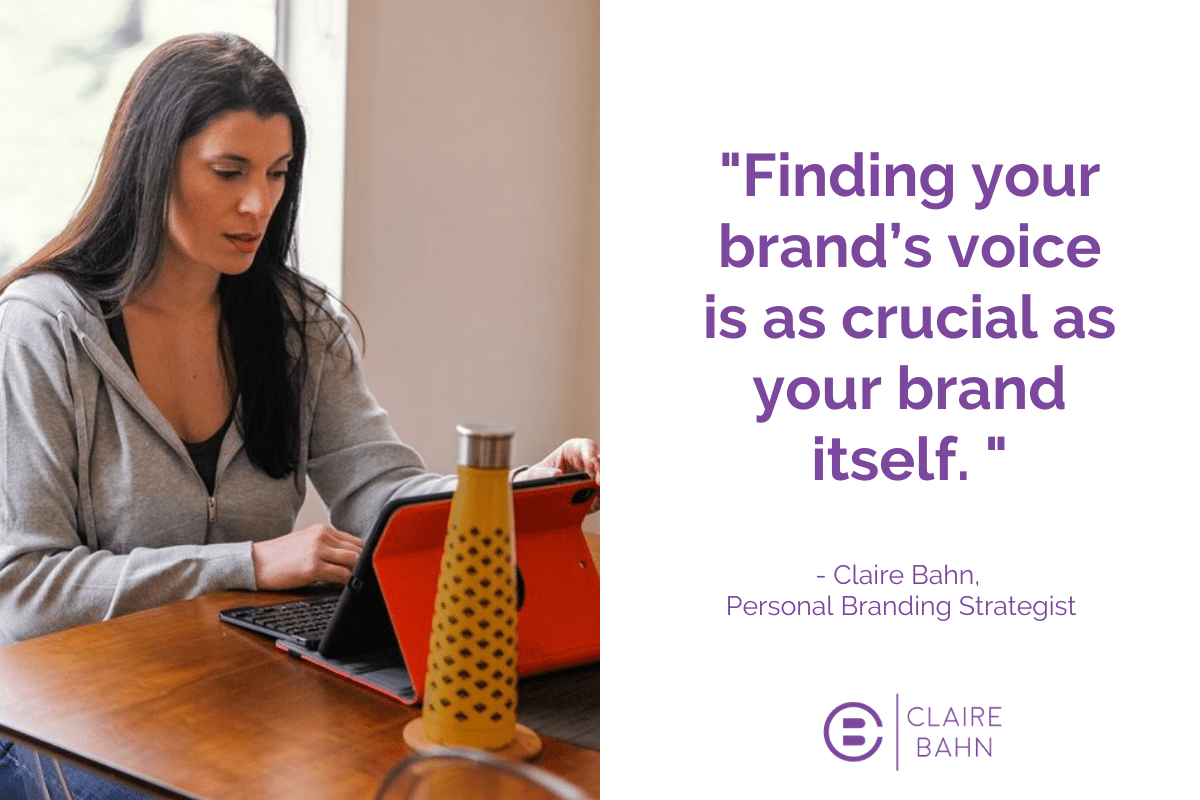If you’ve spent time, money, and an immense amount of effort into cultivating your brand without first defining your personal brand voice, then you’ll find yourself running in circles wondering why nothing’s working.
Finding your brand’s voice is as crucial as your brand itself.
Some people may argue that the two are entirely different concepts that cannot be thought of as a whole.
I disagree.
Without knowing your personal brand voice, you’re less likely to create and manage a consistent business that appeals to your ideal clientele.
Relying on your branding alone results in passive impressions from potential clients. Sure, you’ve got an impeccable fashion sense and a ton of social media followers, but ultimately… you’re forgettable.
Sorry, but it’s the truth. And I’m not here to waste your time.
Tapping into your brand’s voice urges those potential clients to take action instead of just scrolling through your content for a few seconds then moving on to the next trending post.
Why It’s Important
Now, there’s no shame in hiring stylists or spending hours agonizing over your logos. As I said, branding and voice go hand-in-hand and I highly encourage having a polished, professional look.
But unlike flashy household brands that market the crap out of products like toothpaste and window cleaner, your brand should be marketing you as an individual – not just a surface-level attempt at landing new clients.
It’s the same reason some of us prefer to grab a coffee at a locally owned café than heading to an international chain.
Or, why we prefer to shop brands that advocate for sustainability efforts than those that push cheaply-made products with little human interest.
Transparency has quickly become one of the biggest defining factors of a business’s success.
Unsurprisingly, 86% of Americans believe that a brand’s transparency is more important to them than ever before.
Building your personal brand’s voice will help your business reach a state of transparency that encourages clients to take action the next time they come across your profiles.
What Is Your Brand Voice?

So, what do I mean by building your “voice”?
Your brand voice is your own distinct personality that is reflected in your brand’s digital communications. In fact, your personal brand’s content should echo the way you naturally talk in real life.
Well, most of the time.
Your brand’s voice can be as colloquial and humorous, or as brash and serious as you’d like it to be.
This may sound like a risky idea to some, but I promise you that it will take your personal brand to an entirely new level. A level that refined branding just can’t accomplish on its own.
Here’s a validating reminder: There is no one else like you.
And that’s exactly what you need to keep in mind when determining what sort of message you want your personal brand to push outside of the services and products you offer.
RELATED: PERSONAL BRANDING FOR SMALL BUSINESS OWNERS
How To Find Your Personal Brand Voice

Finding your personal brand voice may seem as daunting as learning how to find your purpose in life.
It’s what helps to define the mission, purpose, and ultimate success of your brand.
That’s a lot of pressure – I know.
While I may not have the answers to all of life’s biggest questions for you, I can tell you that learning your brand’s voice isn’t as daunting as it sounds.
Doing a bit of research, business analysis, and a refresher on adjectives will help you determine your brand’s voice.
No matter what, you need to ensure that your voice resonates with your values and who you are as a person. Even though a certain amount of technical work goes into it, remember your brand’s voice should feel like an honest reflection of yourself.
Whether this means taking a few hours to yourself during the weekend or taking a week-long meditative retreat to figure it out, make sure your personal brand’s voice is something that you can speak on for years to come (that’s not to say that you can’t morph your business into something new in the future, though).
My personal entrepreneurial journey has taken me through travel blogging, managing online profiles, and now, being a personal branding expert. There’s no shame in the evolution of your business ventures or your brand’s voice.
Your personal brand voice is just as crucial as your business’s ROI, funding, and social proof. Finding it takes more than just scribbling ideas down on a notepad. But like anything else, the more effort you put into it, the better your results will be.
Step 1. Describing Your Brand
The best place to start searching for your personal brand voice is to brainstorm adjectives that best describe you..
Your personal brand is not just any other cheap marketing scheme. It’s your accomplishments, goals, and passions. Treat it as if it’s an extension of yourself.
Humans are far more complex than a colorful logo or a meticulously styled photoshoot. Your brand’s voice is the opportunity to prove to your audience that you are, in fact, a human.
Start by finding 3 words that describe you. Yes, just you. Not what solely defines your business and the products or services it provides.
Imagine being in an interview and they ask you the same question. What would you say? What do you value? What have been your go-to descriptors in past interviews?
I suggest listing every word that comes to mind before narrowing the list down to just 3. It’s not the easiest task to name yourself in just 3 adjectives, which is why it’s a common interview question.
Words like curious, driven, optimistic, passionate, intelligible, open-minded, creative, determined, self-reliant, humble, and focused may come to mind. These are all admirable qualities to have, so take pride in the 3 words you choose.
Now, I want you to find 3 words that describe your business.
Marketing, technology, culture, people, finance, management, and development may help to describe aspects of your business.
Once you’ve chosen 3 words for both yourself and your business respectively, determine where those 6 words overlap.
It’s in these overlapping descriptions that you’ll find your brand’s words.
Whatever words you choose, make sure that those words can be used to describe the content you’re producing and aligns with the way you plan to present yourself online.
RELATED: HOW TO BECOME AN INDUSTRY LEADER
Step 2. Do Your Research
Guaranteeing that your personal brand voice stands out among the rest requires some sleuthing around your industry.
I normally advise against comparing yourself to other businesses. It can quickly lead to limiting beliefs that do more harm than good to your brand. So please be mindful of why you’re investigating your competitors in the first place.
In this case, you’ll need to analyze your competitors to better understand how they present themselves to their audiences.
Start by perusing around LinkedIn, Twitter, Instagram, and YouTube to find some of your competitors’ most recent content.
Do they come across personable and humorous? Or do they seem intense and brash?
Are they vocal about their political opinions? Or are they accepting of everyone in their audience?
Maybe, some of them don’t have a brand voice at all?
After you’ve got a strong grasp on what it is other people are doing in your industry, it’s time for you to figure out how you can be different.
Sometimes taking a second look at your brand’s model and niching down your target audience can make finding your unique voice a bit easier. Honing in on a niche will help you to stand out more quickly than attempting to cover a broad audience.
If you’ve got your ideal audience nailed down, start thinking about the brand characteristics that you enjoyed. Find a way to incorporate similar, but different, qualities into your personal brand voice.
RELATED: WHY PERSONAL BRANDING IS THE KEY TO SUCCESS IN 2021
Step 3. Write It All Down
I’ve said this before, but consistency is key to anything you do for your businesses, and it’s especially important in maintaining your personal brand voice.
To think being consistent with your voice and your content doesn’t really matter would be poor judgment. To make sure you’re hitting the consistency mark, write down your definition of your brand’s voice. All of that brainstorming and research should culminate onto a single page that you can easily refer back to.
List your brand “words” or adjectives and devise a list of topics you can speak on that will accurately display your unique voice.
If you want to make your brand appear personable, you could discuss some of the challenges you faced while establishing your career. If you’d prefer to keep it serious, sharing your thoughts on common mistakes of the industry could be helpful for your audience and prove to them that you know what you’re talking about.
Your ultimate goal here is to figure out how you don’t want to be seen.
RELATED: WHAT IS REPUTATION MANAGEMENT AND REASONS YOU MIGHT NEED IT
Step 4. Know Your Audience
It’s unrealistic to think that every human on earth will like you. So why would you hold your personal brand to the same standard?
You want to make sure that you’re attracting the right audience for the right reasons. You don’t want to appeal to anyone and everyone just to grow your social media following.
If your follower count is all that matters, then you’ll be disappointed when your thousands of followers don’t interact with your content or don’t purchase from your brand. This is also why focusing on vanity metrics can be so damaging to a business.
Your voice has to resonate with your audience in order for it to be effective. First, you need to figure out who you want to speak to. Do you want to speak to women, men, or both? What is their age group?
Then, it’s important to determine the wants, needs, and likes of your target audience. Once you outline this, you’ll know how to formulate your content and speak to them in a way that sells your services (or products) organically.
When you’re planning content, be sure to address these things in your posts so that your ideal client knows you’re speaking directly to them. If your brand voice is strong, this is what will make people remember you and more importantly: like, know, and trust you.
Conclusion
Using your brand’s voice is what helps you to truly stand out from the crowd. No one else on earth should have the same tone to their branding that yours does.
Before setting out on your entrepreneurial journey, you likely had an idea of your personal brand statement crafted in your head. For me, this equated to several renditions jotted down, crossed out, and rewritten before I landed on the statement that felt like the truest version of my aspirations.
Your personal brand statement is essentially your elevator pitch. It should explain who you are, what you do, and why you’re different from the competitors.
NEXT: PERSONAL BRAND STATEMENT EXAMPLES & TIPS TO CREATE YOUR OWN
Adding a human element by using your brand’s voice helps you to share and to elevate that personal brand statement you worked so hard to craft.
Now, it’s time to learn how to mix branding and personal voice together allows for your business aspirations to turn into successful executions.
You need to own it. And don’t be afraid to use your voice.



